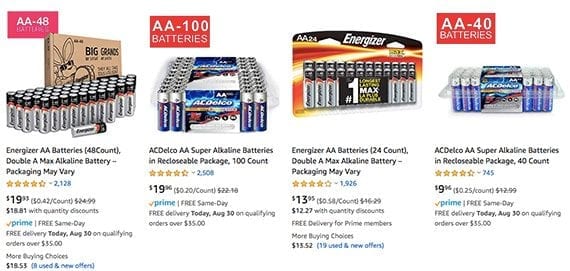On Amazon’s marketplace, a product’s title can be the difference between getting a click or being ignored. Next to a compelling product photo, a title is likely the most important aspect of the description.
Amazon emphasized this when it enacted new product title requirements in June 2019, encouraging clear, concise, and informational titles. Products with titles that do not comply with these guidelines will not appear in Amazon search results.
Most Shoppers Start on Amazon
Not appearing in search results is a severe penalty for two reasons.
First, Amazon’s search is probably how most consumers shop the site. Perhaps a shopper can make her way to vegan sunscreen lotion SPF 30 via navigation to the “Beauty & Health” category or “Sports and Outdoors.” But it is a lot easier to search for that phrase.
Second, some 66 percent of American shoppers start a search for a product on Amazon, rather than on Google, Bing, or Yahoo, according to a 2019 Feedvisor survey of 2,000 consumers.
Even if one argues that a 2,000-consumer survey is not statistically significant, it is worth mentioning that other surveys have also suggested that somewhere between 49 percent and 80 percent of new product searches (with shopping intent) in the United States start on Amazon.
Thus missing out on even the chance to appear on an Amazon search results page should be sufficient motivation to try to write good, customer-engaging titles.
Informational
Copywriting is the art of creating advertising and marketing messages that persuade someone to take action. For Amazon product titles, that action is likely to be a click.
When someone searches for “AA Batteries” in the marketplace, it will be the photo, the price, and a product title that differentiates between more than 60 products on just the first page of results.

An Amazon search results page, like many ecommerce product search results pages, shows relatively little information. There is a product photograph, a price, a Prime badge, and the product’s title.
The photograph gives the shopper an idea of the product. The price is a point of comparison, and the title often confirms the product’s type, specifications, and brand.
The title’s role in the persuasion process is to provide information.
Consider some of the product titles for AA batteries.
- “Energizer AA Batteries (48Count) Double A Max Alkaline Battery”
- “ACDelco AA Super Alkaline Batteries in Reclosable Package, 100 Count”
- “AmazonBasics AA 1.5 Volt Performance Alkaline Batteries – Pack of 48”
- “Rayovac AA Batteries, Alkaline Double-A Batteries (72 Battery Count)”
These product titles tell the shopper the brand name, the product type, an optional detail, and how many batteries are included for the price. Although the exact order of these elements differs slightly, the pattern is:
Brand | Type | Detail | Count
Take, for example, “ACDelco AA Super Alkaline Batteries in Reclosable Package, 100 Count.”
- Brand: ACDelco
- Type: AA Super Alkaline Batteries
- Detail: in Reclosable Package
- Count: 100 Count
In combination with the price and photograph, these titles confirm to the shopper what she is getting, and, thereby, enable the click to the product page to consummate the purchase.
These battery descriptions also meet some of the new Amazon title requirements, including:
- Titles must contain product-identifying information, such as “hiking boots” or “umbrella.”
- Titles must not contain promotional phrases, such as “free shipping,” or “100% quality guaranteed”.
Thus when you write Amazon product titles, look for patterns similar to the one described for AA batteries within your product’s Amazon category.
In the clothing category, titles tend to follow a pattern like this:
Brand | Gender | Detail | Type
For example, “Under Armour Men’s Tech Golf Polo Shirt”:
- Brand: Under Armour
- Gender: Men’s
- Detail: Tech Golf
- Type: Polo Shirt
Concise
Amazon limits product titles to 200 characters, including spaces. Type 201 characters and Amazon will not include it in search results.
Two-hundred characters, however, is a lot to work with. In fact, the above paragraph — the one that starts “Amazon limits product titles…” — was just 136 characters, including spaces. And if your product title is as long as that paragraph, you better have a good reason for all of those letters.
Instead, aim for about 50 – 80 characters.
There is a memorable scene in the movie “A River Runs Through It” wherein the protagonist describes being homeschooled.
“I attended the school of the Reverend Maclean. He taught nothing but reading and writing. And, being a Scot, believed that the art of writing lay in thrift.”
Take that advice and write pithy titles.
Clarity
Amazon product titles should be clear. This means you should avoid odd punctuation and special characters. Amazon stated, “Titles must not contain characters for decoration, such as ~ ! * $ ? _ ~ { } # < > | * ; ^ ¬ ¦”.
Beyond Amazon’s rules, avoid capitalizing entire words (unless it is a brand requirement), abbreviating weights and measurements, or adding unnecessary opinions
For example, it is better to write “48 Count” than “forty-eight Ct.” Likewise, “48 Count” is better than “an amazing 48 Count.”






